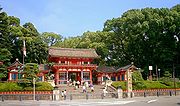
Yasaka Shrine
Encyclopedia

Shinto
or Shintoism, also kami-no-michi, is the indigenous spirituality of Japan and the Japanese people. It is a set of practices, to be carried out diligently, to establish a connection between present day Japan and its ancient past. Shinto practices were first recorded and codified in the written...
shrine in the Gion
Gion
is a district of Kyoto, Japan, originally developed in the Middle Ages, in front of Yasaka Shrine. The district was built to accommodate the needs of travelers and visitors to the shrine...
District of Kyoto
Kyoto
is a city in the central part of the island of Honshū, Japan. It has a population close to 1.5 million. Formerly the imperial capital of Japan, it is now the capital of Kyoto Prefecture, as well as a major part of the Osaka-Kobe-Kyoto metropolitan area.-History:...
, Japan
Japan
Japan is an island nation in East Asia. Located in the Pacific Ocean, it lies to the east of the Sea of Japan, China, North Korea, South Korea and Russia, stretching from the Sea of Okhotsk in the north to the East China Sea and Taiwan in the south...
. Situated at the east end of Shijō-dōri (Fourth Avenue), the shrine includes several buildings, including gates, a main hall and a stage.
History
Initial construction on the Shrine began in 656.The Shrine became the object of Imperial patronage during the early Heian period
Heian period
The is the last division of classical Japanese history, running from 794 to 1185. The period is named after the capital city of Heian-kyō, or modern Kyōto. It is the period in Japanese history when Buddhism, Taoism and other Chinese influences were at their height...
. In 965, Emperor Murakami
Emperor Murakami
was the 62nd emperor of Japan, according to the traditional order of succession.Murakami's reign spanned the years from 946 to his death in 967.-Traditional narrative:...
ordered that Imperial messengers were sent to report important events to the guardian kami of Japan. These heihaku were initially presented to 16 shrines; and in 991, Emperor Ichijō
Emperor Ichijo
was the 66th emperor of Japan, according to the traditional order of succession.Ichijō's reign spanned the years from 986 to 1011.-Traditional narrative:Before he ascended to the Chrysanthemum Throne, his personal name was Kanehito-shinnō....
added three more shrines to Murakami's list. Three years later in 994, Ichijō refined the scope of that composite list by adding Umenomiya Shrine
Umenomiya Shrine
is a Shinto shrine located in Ukyō-ku in Kyoto, Japan.-History:The shrine became the object of Imperial patronage during the early Heian period. In 965, Emperor Murakami ordered that Imperial messengers were sent to report important events to the guardian kami of Japan...
and Gion Shrine.
From 1871 through 1946, the Yasaka Shrine was officially designated one of the , meaning that it stood in the first rank of government supported shrines.
Matsuri
In 869 the mikoshiMikoshi
A is a divine palanquin . Shinto followers believe that it serves as the vehicle to transport a deity in Japan while moving between main shrine and temporary shrine during a festival or when moving to a new shrine...
(portable shrines) of Gion Shrine were paraded through the streets of Kyoto to ward off an epidemic that had hit the city. This was the beginning of the Gion Matsuri
Gion Matsuri
The takes place annually in Kyoto and is one of the most famous festivals in Japan. It spans the entire month of July and is crowned by a parade, the on July 17. It takes its name from Kyoto's Gion district....
, an annual festival which has become world famous.
Today, in addition to hosting the Gion Matsuri, Yasaka Shrine welcomes thousands of people every New Year, for traditional Japanese New Year
Japanese New Year
The is one of the most important annual festivals, with its own unique customs, and has been celebrated for centuries. Due to the importance of the holiday and the preparations required, the preceding days are quite busy, particularly the day before, known as Ōmisoka.The Japanese New Year has been...
rituals and celebrations. In April, the crowds pass through the temple on their way to Maruyama Park
Maruyama Park
' is the main center for cherry blossom viewing in Kyoto, Japan, and can get extremely crowded at that time of year . It also becomes busy in the New Years Eve Festivals. The park's star attraction is a weeping cherry tree which becomes lit up at night...
, a popular hanami
Hanami
is the Japanese traditional custom of enjoying the beauty of flowers, "flower" in this case almost always meaning cherry blossoms or ume blossoms. From the end of March to early May, sakura bloom all over Japan, and around the first of February on the island of Okinawa...
(cherry blossom viewing) site. Lanterns decorate the stage with the names of festival sponsors.
See also
- List of Shinto shrines
- Twenty-Two Shrines
- Modern system of ranked Shinto ShrinesModern system of ranked Shinto ShrinesThe The The (sometimes called simply , was an organizational aspect of the establishment of Japanese State Shinto. This system classified Shinto shrines as either official government shrines or "other" shrines...

